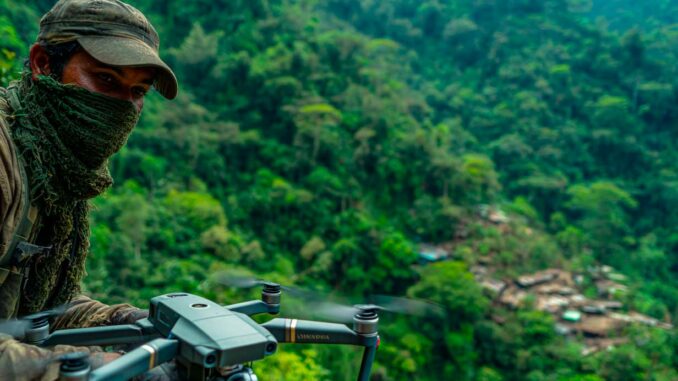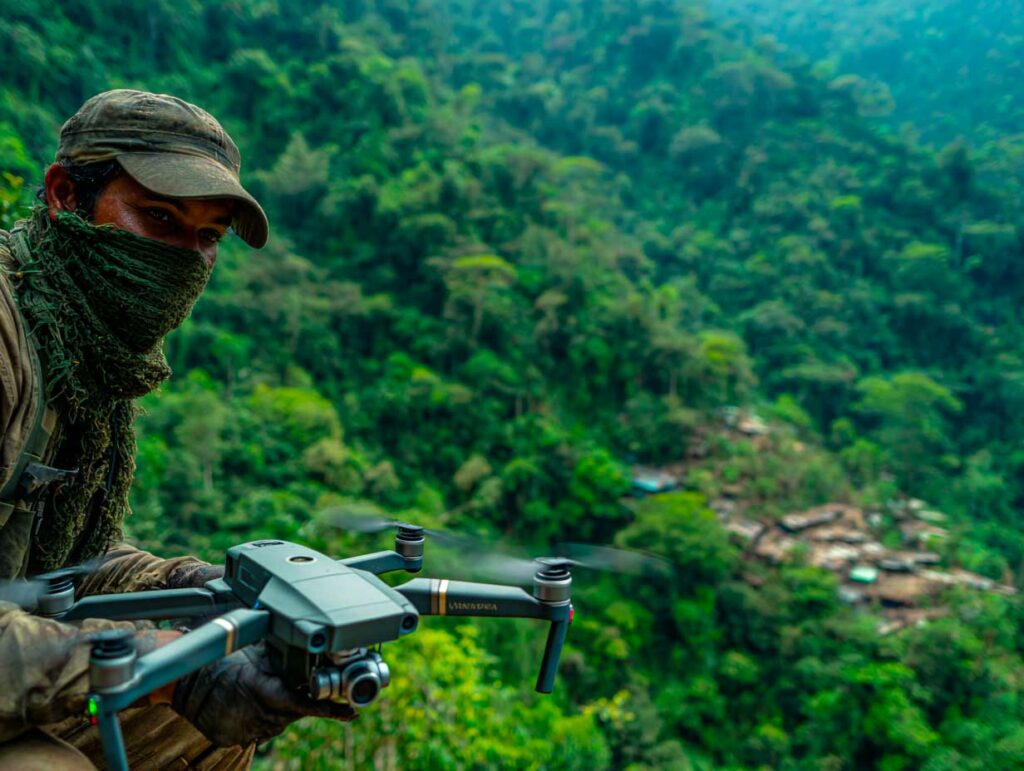
Cheap armed drones are costing Colombia dearly: figures, maps of hotspots, doctrinal flaws, and an operational anti-drone plan.
Summary
Since 2024, Colombian armed groups have been operating a ‘poor man’s air force’ based on modified commercial drones: reconnaissance, dropping 60 mm grenades, coordinated attacks on patrols, field hospitals, police stations and river units. Between April 2024 and mid-2025, the authorities recorded more than 320 attacks and 700 improvised charges, resulting in at least 225 victims, including 17 deaths. The hotspots follow the cocaine and illegal gold corridors: Cauca, Catatumbo, Arauca, and southern Bolívar. Entry cost: a few hundred dollars (≈ €250-€800) per multi-rotor or FPV drone, with components imported or purchased online. The state’s response remains fragmented: limited counter-drone resources, incomplete doctrine, scattered purchases, and a vague legal framework. The key recommendation: a unified counter-drone command, modular architectures and guaranteed software updates, electronic warfare training at brigade level, and regional coordination with Ecuador at a minimum.
Operational findings and key figures
The attacks of August 2025 served as a wake-up call: a helicopter destroyed near a frequently used landing zone, a Colombian Navy vessel rammed by an aircraft loaded with explosives, patrols grounded in small towns where suspicion immediately fell on drones. This is no longer a tactical hazard: it is the complete integration of light aircraft into combined operations. Insurgents now combine reconnaissance, decoys, improvised explosive devices and indirect fire, forcing forces to make unfavourable trade-offs: covering the sky leaves angles open on the ground, and vice versa. Data accumulated since April 2024 shows a sustained pace: more than 320 actions involving 700 charges (grenades, dropped or fixed IEDs), more than 225 victims, including 17 fatalities. The average frequency – approximately one attack every 38 hours – illustrates a threshold of artisanal industrialisation: Telegram channels for maintenance, accessible parts, and collective learning.
The economic differential is stark. Whereas a modern rifle can cost over €1,200, a reconfigured civilian drone (2–4 kg multirotor, 4K camera, 3–7 km range) can be purchased for €250-€800, batteries included. A ‘ready-to-fly’ FPV kit based on common components costs less than €600, excluding charges. Insurgents quickly recoup these costs through the psychological effect, the material attrition inflicted, and the constraints imposed on the movements of forces. All of this is based on previous expertise in IEDs: directional charges, delayed fuses, adaptation of 60 mm grenades or light mortars. The result is a low-cost, scalable aerial threat that reduces freedom of action and imposes an energy-intensive defensive posture, even in urban centres.
Criminal geography: corridors, borders and knock-on effects
The incident map overlaps with cocaine and illegal gold mining corridors. Cauca is home to enclaves where the terrain, scattered hamlets and secondary roads make enforcement difficult. Catatumbo, on the border with Venezuela, combines areas of refuge, cross-border logistics and open terrain for discreet take-offs. Arauca and southern Bolívar complete this criminal ‘sweet spot’: relative remoteness, river access, and export hubs. In El Plateado, drones struck patrols, a hospital and a school, then a square. Inter-group clashes show a further escalation: the use of drones for local superiority between FARC and ELN dissidents, with drop-offs and short-loop reconnaissance.
The regional environment favours these cycles of adaptation. Venezuela’s porous borders facilitate the passage of components, countermeasures and technical advisers, while Ecuador is becoming a transit zone for off-the-shelf aircraft. Logistical overlaps with Mexican cartels (transfer of priming methods, load optimisation) are plausible in view of the operating methods. On the social side, recruitment includes minors trained as pisasuaves or operators, with programmes on night flying, charge assembly and the integration of video feeds into ground manoeuvres. This accelerated learning environment transforms the strip of land from Cañón del Micay to Catatumbo into an open-air laboratory: same equipment, tactics adapted to the terrain, and rapid dissemination via encrypted messaging.
The state’s response: doctrinal gaps and a failing acquisition chain
The diagnosis is severe: fragmented counter-drone capabilities, decommissioned air defence batteries, partial doctrine, and an uncertain legal framework. On the ground, isolated units admit to resorting to saturation fire with rifles, which is random and costly in terms of ammunition. Commercial jammers and direction-finding antennas are being tested, but without modular architecture or guarantees of software updates, the risk of obsolescence is high. Purchases follow a familiar pattern: lengthy procedures, fragmented decisions, changing priorities. The deployment of imported ‘turnkey’ systems is hampered by adverse adaptations: frequency hopping, pre-programmed autonomous flights, very low profiles, and rapid incursions in FPV.
Operational law adds another layer of uncertainty. Military lawyers interpret the margins offered by the law of armed conflict restrictively, in order to limit the legal risk to the command, at the cost of inertia that wastes time and positions. The result: inconsistent rules of engagement, hesitation to engage in offensive jamming, and dilution of responsibilities between the army, air force and policía nacional. Finally, current coverage focuses on bases and airports, while the threat strikes in secondary locations, bridges and river routes; maintenance and spare parts remain underfunded. Until detection, attribution and electronic neutralisation are brought under a unified framework, the adversary will retain the local initiative.

The action plan: counter-drone command, layers and figures
The priority is organisational: to create a single counter-drone command, with a multi-year budget, overseeing doctrine, R&D, acquisition and training. The objective is to establish multi-layered defences that can be replicated at brigade/regional level. A first passive layer detects: acoustic, radio frequency (RF), emission mapping, EO/IR on 6–10 m masts. Target unit cost: €150,000–€300,000 for a fixed node covering 3–5 km in a mixed environment. The second layer acts: directional jamming (uplink/GNSS), protocol control takeovers where legally possible, and short kinetic effects: 12-gauge shotguns with frangible ammunition, micro-missile nets, low-power lasers for optics. Cost: €250,000–€600,000 per site depending on density. The third mobile layer follows convoys: 4×4 vehicles with RF sensors and 50–100 W jammers, consumption <1 kW, exchangeable batteries, cost €80,000–€150,000 per vehicle. Finally, the procedural layer: 90-second RF silence drills, route changes, and temporary RF ‘cages’ over helicopter landing zones.
In terms of human resources, each brigade in the red zone must include an EW section (8–12 personnel), with 120 hours of initial training (RF, signatures, ammunition safety) and four joint exercises per quarter. River units will have waterproof RF pods, phased array antennas, and 360° monitoring procedures. Public procurement will benefit from requiring open APIs, 5-year update contracts and interoperability with SIG and L16/VMF where available. At the same time, a Colombian SME-industrial window must co-finance the local production of masts, antennas, software radios and boxes resistant to 40°C and 95% humidity.
Collateral effects and risk projection
Three major consequences are emerging. First, state mobility is reduced: helicopters land less often in repetitive LZs, lengthening medical evacuations and delaying support. Second, security fragmentation is increasing: forces protect fixed points at the expense of zone control, which gives illicit economies room to breathe. Finally, technological metastasis is likely: drone expertise is being transferred to UUVs (handmade submersibles), already used for maritime trafficking, and to remote-controlled land vehicles. Maritime borders will have to anticipate surface drones travelling at 10–15 knots, with low signatures, costing €3,000–€10,000, loaded with explosives or packages.
The international dimension carries greater weight. The United States is redirecting its support for the fight against drugs towards counter-drone capabilities: advice, targeted transfers, and sharing of experience from Ukraine and the Middle East. Cooperation with Venezuela remains unlikely; realistic efforts involve Ecuador (transit control), Brazil (river intelligence) and NATO partners for doctrinal feedback. Public opinion is not supportive of frequent air alerts and the temporary closure of civilian areas; clear crisis communication will be required: temporary no-fly zones around schools and hospitals, and simple information on procedures in the event of suspicious overflights.
War Wings Daily is an independant magazine.